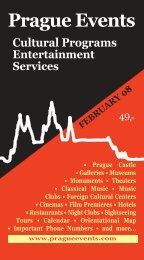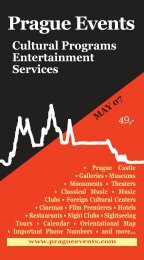The highest building in Prague - Prague Events
The highest building in Prague - Prague Events
The highest building in Prague - Prague Events
Create successful ePaper yourself
Turn your PDF publications into a flip-book with our unique Google optimized e-Paper software.
36<br />
Galleries Culture and Enterta<strong>in</strong>ment<br />
GALERIE RUDOLFINUM<br />
Alšovo nábř. 12, <strong>Prague</strong> 1, tel.: 227 059 349<br />
e-mail: galerie@rudolf<strong>in</strong>um.org<br />
http://www.galerierudolf<strong>in</strong>um.cz<br />
open Tue-Sun 10 am-6 pm<br />
Erw<strong>in</strong> Dubský's Naval Diary, until Apr 15<br />
<strong>The</strong> exhibition presents a unique collection of historical photographs of<br />
Japan from the 1870's that was recently found at the Lysice castle. 158<br />
Japanese photographs, made us<strong>in</strong>g a contemporary popular technique on<br />
albumose paper, is presented <strong>in</strong> public for the first time ever. Due to the<br />
sensitivity of the orig<strong>in</strong>als, the exhibition is divided <strong>in</strong>to two parts that<br />
can be accessed <strong>in</strong> two thematically equivalent cycles. <strong>The</strong> images present<br />
the period of fundamental changes <strong>in</strong> Japan after it was opened up to<br />
the rest of the world aga<strong>in</strong>. This moment creates a historical parallel with<br />
the work of Shomei Tomatsu and allows for the historical comparison of<br />
the dynamics and the depth of the changes with a soft touch of nostalgia<br />
result<strong>in</strong>g from the long time passed.<br />
Prepared <strong>in</strong> cooperation with the Moravian Gallery <strong>in</strong> Brno and the<br />
National Monument Preservation Institute, curated by Filip Suchomel.<br />
Along with the exhibition, a representative publication is released with a<br />
detailed description of all the photographs presented.<br />
Shomei Tomatsu - Sk<strong>in</strong> of the Nation, from Jan 11-Feb 15<br />
This extensive retrospective of Tomatsu (born <strong>in</strong> 1930 <strong>in</strong> Nagoja) is the<br />
first general overview of his work and it shows not only his position <strong>in</strong> the<br />
field of Japanese postwar avant-garde but also his role <strong>in</strong> the evolution of<br />
modern Japanese photography. By means of approx. 260 items, the exhibition<br />
presents all the important areas of Tomatsu's work, e. g. 'Nagasaki<br />
11.02' - an appall<strong>in</strong>g testimony of the consequences of the explosion of<br />
the atomic bomb and of lives of those who survived - of 'Chew<strong>in</strong>g Gum and<br />
Chocolate', which is the author's first attempt to document the far-reach<strong>in</strong>g<br />
americanisation of postwar Japan that was characterised by the contrast<br />
between the presence of American soldiers and the <strong>in</strong>fluence of<br />
American pop-culture.<br />
With Shomei Tomatsu, we are transferred from a traditional Japan to a<br />
Japan of economic success, where many economic, political and also cultural<br />
changes are <strong>in</strong> progress. <strong>The</strong> father of modern Japanese photography,<br />
one of the most expressive Japanese artists of the last 50 years, <strong>in</strong>fluenced<br />
the work of Nobuyoshi Araki and Daido Moriyama as well as (later)<br />
Seiichi Furuya, Takashi Homma and Yoshiko Se<strong>in</strong>o.





